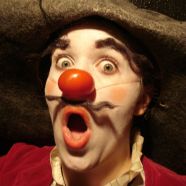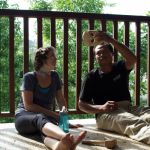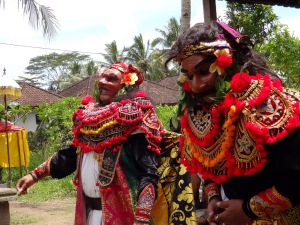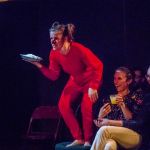The Masks We Wear
There are a million white female actors who look exactly like me. When I speak to agents and casting directors they tell me I should go for roles like the girl next door, a college student, maid, young mother, and kindergarten teacher. I agree, my body, my face, my mask fits those generic descriptions. However, I am not always impressed by the character development of these roles and have always wanted to embody ones with a wider range. I knew this in my early twenties while living in New York City and I began the search for a place where I could train and learn how to develop characters that expressed any body type, physicality, age, or gender. I found Dell’Arte International School of Physical Theatre in Blue Lake, California, and enrolled in their three-year MFA program for Ensemble-Based Physical Theatre. It is a three-year graduate program for advanced students who wish to undertake a performance path of actor-created, physically dynamic ensemble theater making. Throughout the three years, a student is immersed in different style blocks that focus on creating characters inspired through the physical body. Mask training is one of the many tools Dell’Arte uses to train and transform their students. Larval masks, emotion masks, Commedia Dell’Arte half masks, topeng masks, and clown are heightened styles of theater that force the student to extend themselves beyond their comfort zone and beyond a contemporary range of characters. Through this training, I soon began to recognize that the actor body is limitless in its ability to transform into any character. Studying at Dell’Arte International School of Physical Theatre became one of the best decisions I ever made as an actor, teacher, and creator.
Traditional Balinese Mask
In 2014, my third year at Dell’Arte, I spent a month studying mask carving, Balinese women’s dance, and Topeng mask in Ubud Bali through Dell’Arte’s international internship program. Bali was the selected destination because those who appreciate the study of mask know the most accomplished mask performers are from Bali. For thousands of years the Balinese people have passed down their historical, religious, and cultural stories through the mask performance, as it is a sacred art form. Before you even place a mask on your face, you are taught to hold it in your hands, survey its angles, ridges, and planes, and study its curves. The thought is that when you spend time with it, the mask will tell you who this character is: its voice, its gait, and, most importantly, its perspective.
It takes about a month for a trained mask carver in Ubud to carve, sand, paint, and polish a traditional Balinese mask out of pula wood. The wood shavings should peel like butter and fall off in excess as the face of the mask emerges. A great mask will reveal its identity through “its gaze.” The gaze is the intrinsic power of each mask to identify and place its focus on a single audience member, revealing its point of view. A poorly made mask will lack a gaze and should be discarded or hung as a mere decoration.
- Mask carving
- Getting Feedback from Nyoman Seitwain
The name of the masked dance form performed at most Balinese ceremonies is Topeng. Topeng is a powerful yet graceful dance with articulated walks, postures, and isolated gestures—accompanied by a gamelan orchestra. Every movement is calculated to express different emotions through the mask; every flick of the wrist or fluttering finger has its own punctuated orchestral sound ignited by the mallets of the musicians. The mask performer and the gamelan orchestra perform as one unit, listening and responding to one another.
The most powerful mask performance I have ever experienced was performed by Gustu, a master Topeng performer and my teacher. One hot Sunday in January 2014, Gustu was asked to perform a cremation ritual with a half Balinese minister mask. His local priest had died and his community had come together for an entire day to perform the varied rituals to honor his death. The traditional minister mask has a large mustache, bushy eyebrows, and fierce, painted eyes. As Gustu began to move, he would isolate specific parts of his body with staccato punctuation. A small but sharp movement of the head or neck would draw the eyes of the mask to the side. A sudden bounce in the shoulders would express anger. A fluttering pinky would bring anxious anticipation. His feet would glide as his pelvis and hips initiated each sequence. As he traveled across the dirt path of a Balinese home, I began to see the painted eyes of the mask move from side to side, creating the illusion that the eyes of the mask were moving. It was magic. As an audience member and even with the objective intent of a critic of performance, I was convinced that his movements made the mask come alive. Gustu would later correct me by saying, “the mask informed my movement.”
Balinese artists do not perform for personal satisfaction or ego. The Balinese perform mask rituals, Balinese dance, and shadow puppetry because they are called to do so by the community. There is a cultural understanding of the need for performers to tell the stories of their people, helping community members remember and reclaim who they are. Gustu becomes an instrument for the Balinese spirits; they come through him when he wears and performs mask. He acknowledges that his performance is a religious and sacred experience. The Balinese people support him in his artistry because his performance is necessary and is honored for religious practices.
I recall an instance when Gustu judged that a certain novice mask performer in Bali was too caught up in his head. I overhead him proclaiming, “He can’t hear the spirit of the mask, he’s not ready.” I learned and came to an understanding that in order to perform one has to let go, breathe, listen, and connect to the spirit of the mask.
Clown
Most of us are familiar with the smallest physical mask, the red clown nose. A red clown nose is an amplifier. It heightens all expressions of the performer, as though putting a spotlight on the internal experience of the actor. This style of training can be truly frightening to the student because no one can hide when they put the clown nose on. It is the best training tool to call out the bullshit, the fake, the façade, the overly clever, the pusher, the insecure, and ultimately the student who won’t allow herself to be laughed at.
One of the most difficult clown exercises I have personally endured occurred while studying at Dell’Arte in the spring of 2012. My clown teacher, Ronlin Foreman, told me to put on my red nose, come out from behind the curtain, and “be funny.” This prompt both terrified me as well as placed an immense pressure on the room. Whatever trick or clever thought I came up with fell flat. I danced, I pushed, I ran around the space, I mimed something inane, I rushed everything, and I panicked. Then I got a small giggle when I let go and fell into my own wandering thoughts, forgetting the presence of the audience. I realize that I am a dreamer at heart and this fosters an ability to play in an imaginary landscape that comes alive only when I live onstage, under the lights, when an audience is in attendance. I laughed at my wandering self, my doe-eyed qualities and the audience laughed with me. I discovered a complete release through wearing a red nose and a character was born.
The study of clown is the perfect medicine to remind us that we are all imperfect, lost, naïve, innocent, guilty, and flawed—and lots of other things we would like to hide. This self-awareness is part of what we learn when we study clown, recognizing things about ourselves that are just downright embarrassing. We take this work and transfer it into a clown and this clown will live and perform for us without knowing its shortcomings. The audience laughs because we recognize the suffering or shortcomings of the clown in ourselves.
Some people are afraid of clowns and I have a theory about this. It goes back to the work of the mask, as I discovered in Bali. A clown’s makeup, or painted mask, tells us exactly who we imagine them to be. We see thick eyebrows and we imagine a grumpy clown, we see a bucktooth, and we imagine a dumb clown, and so on. We judge people based on the features and expressions of their face. If a clown’s makeup does not match the expression of the actor wearing the makeup, this is a quick signal to the audience that something is wrong. For example, if the makeup of the clown is happy and joyful and the actor behind the makeup is insecure or anxious, the red nose is going to amplify the actor’s anxiety. In this instance, the audience immediately recognizes something is untrustworthy or seriously unauthentic about the performer. The abiding principle exists for mask or clown performance, that the performer has to let go of personal resistance or preferences and give himself over to the red nose. There is a clown in all of us, whether we want to admit or not, so you might as well lean in and put on the red nose.
Neutral Body/ Neutral Mask
Inhabiting a neutral body is fundamental. Before training in any mask form, one must learn to stand grounded without a physical or metaphorical mask, without tension, fear, or shame. Before an actor physically transforms into any character, roles of commedia, clown, bouffon, Greek tragedian, Shakespearean, contemporary characters, whatever, he or she needs to arrive present and available.
Entering with a neutral body is the practice of walking onstage and allowing oneself to be seen. It takes a great deal of courage and a calm heart to look into the eyes of the audience and see oneself being witnessed. In life, we all put on faces, demeanors, personas, or actual masks in the hopes of being accepted. We are conditioned to do so. However, the most attractive, most engaging mask a person can wear is the body sans any barrier—to stand before the audience stripped, completely naked (metaphorically speaking), vulnerable, honest, genuine, and fearless to the world. This is captivating. This draws people in.
I’m a petite woman. My spine stretches toward 5’2” but never touches the line. I was always told I was small growing up. This evidently had an impact on the way I presented myself on stage. One of the first pieces of critique I received while in graduate school was, “Don’t be small; you are not small.” I would barely take up any space. I knew how to hide in the corners. I could easily be forgotten or recognized for one of my peers. I learned to admit that even though I lived in a petite body, my wild spirit and big heart were dynamic forces that could not be contained. In order to be seen, I had to extend myself energetically. Even to this day, I imagine an electric current shooting out of my body and filling the space between the audience and myself. The best exercise to help cultivate this radical presence is to ask someone to walk on center stage and introduce oneself. Very quickly a teacher or director can identify if you are able to connect to an audience. Can you speak to someone, rather than at someone? While you are introducing yourself, are you able to read the room? Are you able to listen and respond? Are you rushing? Are you grounded? Are you holding tension in your body? Are you ashamed? Is the audience with you? Oftentimes, the hardest character to play is myself. It is still a great reminder for me to check in with myself when I am meeting a new group of people. I must hold myself accountable, be present and vulnerable with every new introduction. Cultivating a neutral body with radical vulnerability is the basis of acting, but it is also the basis of being a human being who can connect with another human being.
Mask training does the exact opposite of what one might imagine. A mask does not cover up who you are. It reveals. Mask training helped me uncover the multitude of characters within me. It has become an incredible training tool for me to expand my range and has opened up new realms and worlds for me to create characters beyond how people view me in everyday life. Every time I put on a mask or costume, I realize I am a vessel for that character’s spirit, thanks to studying with Gustu in Bali. Every time I put on a red nose I am reminded that I am human, flawed, and imperfect. Clown has forced me to admit who I am and laugh at my shortcomings. Inhabiting a neutral body has allowed me to connect to people all over the world, who I might never have imagined I would be able to connect to. But the truth is, every person wants to be witnessed and if you allow yourself to be witnessed you can pass the gift on to others. So, cleanse yourself of your insecurities, your shame, and your fear and wear your most truthful, honest, and vulnerable self. The world will be better for it!













